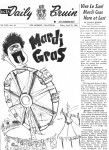Though you’re more likely to associate Mardi Gras with beads and booze than the Lenten tradition, UCLA’s history of celebrating the occasion involved neither.
For decades, Bruins organized an annual Mardi Gras event to raise money for UniCamp, a summer camp for underprivileged kids, and the Recreational Association. The Bruin covered the 1965 event, previewing Mardi Gras King and Queen candidates and documenting the events pitfalls, as it was delayed twice before actually happening.
A paid supplement describing the event claimed it possessed “horrors to terrify you; sex to pacify you; and, oh yes, plenty of excitement.”
However, the 1965 delay was no signal of decline for the festival. It continued to grow and attract big crowds and big names. A decade later, then-LA Mayor Tom Bradley attended the carnival for a spin around the Fun House. It wasn’t until the ’80s that the event peaked, reaching crowds of about 80,000; those numbers would deplete to a paltry 20,000 in 1995, prompting organizers to cancel the 1996 event because of “financial difficulties and security concerns.”
The director of UCLA’s Central Ticket Office at the time, David Lowenstein, told the Los Angeles Times that students were “rethinking the nature” of Mardi Gras, which had declined in success. Instead of netting any sum close to the $200,000 the event generated at its height, student organizers lost $20,000 the year prior. Organizers put the event on an indefinite hiatus, which has persisted for 20 years now without any signs of a comeback.
The LA Times noted the dropping attendance followed a decision three years prior to stop hosting the carnival at night because of security concerns. In 1990, at least 500 attendees stormed the Village post-festivities, wreaking havoc on storefronts.
On the decision to cut the festivities instead of continue to modify them, Lowenstein told the Times, “It’s a student decision on how to formulate an event that can be successful.”
The same can be said of the recent cuts to the student-run JazzReggae Festival. Consistent overspending since 2012 and decreasing ticket sales have reduced the 2016 JRF to a mere shadow of what it once was.
In the past, the Undergraduate Students Association Council Cultural Affairs Commission planned JRF over two days and featured performers such as Snoop Dogg and Lupe Fiasco. This year, the festival returns to its humble origins of featuring student performers in a daylong event.
Ackerman Student Union director Roy Champawat told The Bruin the event will hopefully grow again, but some students said they thought the lack of guest artists could continue the fall in ticket sales.
That isn’t to say JRF is this generation’s Mardi Gras – but sans celebration, let the good times roll.
